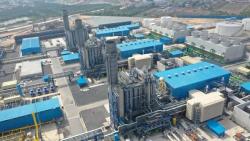
OR WAIT null SECS
© 2024 MJH Life Sciences™ and Turbomachinery Magazine. All rights reserved.
Isothermal and intercooled compression
An isothermal compressor is an old dream of the engineer, based on the value of lower specific power consumption (per unit mass) compared with regular (adiabatic) compressors. This technology could improve the efficiency of gas turbines and related plants. And it can save power in many compression jobs in process plants, especially in cases of high pressure ratio.
The ideal isothermal compressor has not yet been built, with one historic exception shown below. But approximations with adiabatic compressor stages alternating with intercoolers are widely used. Of course in these cases, the space requirement for the coolers is a dominant factor. It is useful to first quantify the power savings of compression with internal cooling by means of an example. The power requirement can be shown as a function of pressure ratio for air with 15°C and 60% relative humidity. Ideal gas behavior with the specific heat being a function of temperature is assumed.
Adiabatic compression with 86% polytropic efficiency is good for a good radial compressor. Each intercooling step requires a pressure loss, which is assumed here with 3% of the absolute pressure level. An additional assumption is that the compression after each intercooling step starts at a temperature level of 35°C (20°C above ambient).
The intermediate pressure level for the intercooling steps has been chosen such that the adiabatic discharge temperatures in each compression step are all equal for the given pressure ratio. Finally there is the ideal limit case of isothermal compression at a temperature level of 35°C and a compression efficiency assumption of 86%. One intercooling step provides more than half the power saving ideally attainable. It is also useful to look at power saving as a function of the number of intercooling steps. An example is a pressure ratio of 100 with the same assumptions as before. The ideal cases of adiabatic and isothermal compression are shown as horizontal lines. The intercooled option has an optimum at 10 intercooling steps.
This demonstrates that the accumulated pressure loss in each intercooling step reduces the advantage for 11 or more intercooling steps. This optimum depends on the pressure ratio and on pressure loss assumptions. But the existence of an optimum number of intercooling steps is a general feature caused by the pressure drops in the intercoolers.
(The complete version of this story appears in the Nov/Dec issue of Turbomachinery International)



